Is PVC Safe for Hydroponics?” This question troubles many gardeners. Hydroponics involves growing plants in nutrient-rich water. No soil is used.
PVC or Polyvinyl Chloride is often used to make water pipes for these systems. But many stress about its safety. This article will dig deep into PVC and its use in hydroponic systems.
We’ll study its benefits, drawbacks, and alternatives. It will help you make a better decision for your garden.
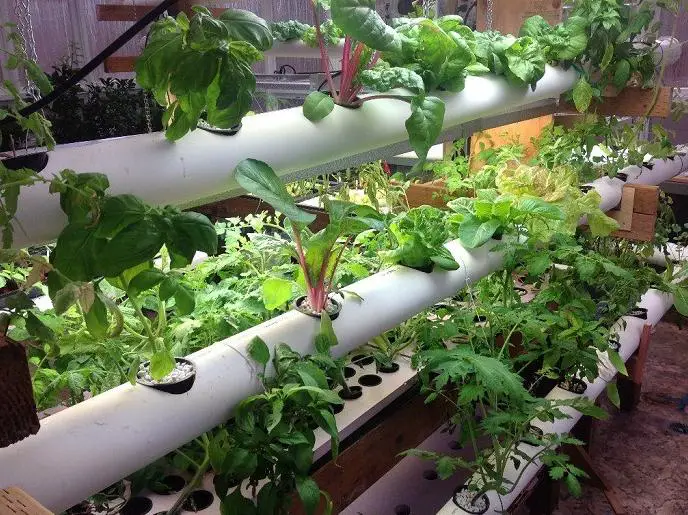
Table of Contents
Is PVC Safe For Hydroponics? (Let’s Bust Some Myths)
Yes, PVC Type 1 is similar to Food grade PVC, also known as unplasticized PVC (uPVC/PVC-U) or rigid PVC. They are both widely used in hydroponics. This is due to their high resistance to chemicals and durability.
What makes them safe for use in hydroponics and aquaponics systems is the absence of phthalates or Bisphenol-A (BPA).
These are chemicals known to cause health problems in humans. Therefore, using PVC Type 1 or food grade PVC, like uPVC, is generally safe as they do not contain these harmful additives.
But, always make sure that the PVC products you choose are labeled as safe for food contact. This ensures they don’t contain any harmful substances.
Regular PVC vs Food Safe PVC
There are some core differences between these 2 types of PVC. The one major characteristic that separates them both was mentioned above: whether or not it is plasticized.
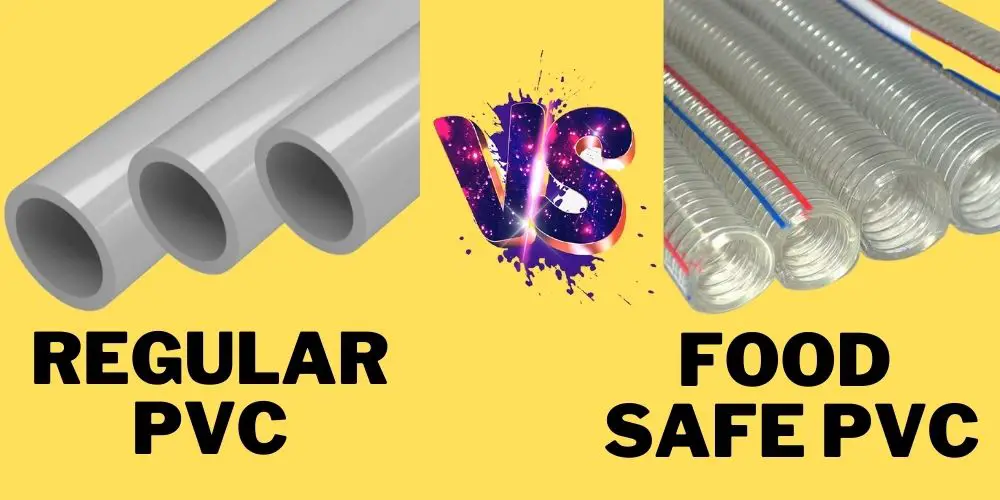
This factor alone makes the types completely different to one another in their usability and functionality. PVC is used in several different industries, but its most common purpose is as a reliable material for construction.
Construction
Regular PVC: Regular PVC is a popular choice of building material within the ever-evolving construction industry. More so within the piping and electrical sectors. The range of piping that Regular PVC can come in is extremely vast and can suit several requirements.
Generally speaking, the piping industry uses the larger, more robust variants for plumbing. It is also a renowned alternative to create systems that deliver and circulate non-potable water. Electricians have also become well-versed using regular PVC, choosing the material to insulate their cables.
Food Safe PVC
On the other hand, uPVC/Rigid PVC has been adopted amongst many other lines of work within the construction industry. Its versatility is its strong suit as it can be fabricated in a range of different colors, shapes and styles to suit the purchasers’ requirements.
You May Also Find Useful: How Often To Change Hydroponic Water?
One of its top characteristics is that it can look exactly like other building materials minus the often hefty costs (e.g., wood, sheet metal, steel). It has also been well received as an alternative for wood in construction. Due to its lower cost and availability, double glazed window frames and window sills can be manufactured cheaper and faster.
uPVC is now being used more widely instead of cast iron pipes where more robust drainage and pumping is required. It can also replace copper and aluminum. Other prevalent uses within the construction sector are waste lines, irrigation systems and pool circulation systems.
Uses of Regular PVC and uPVC
Regular PVC Uses
- Medical equipment and devices.
- Stationary.
- Leather-like or waterproof clothing materials.
- Seat Coverings.
- Flat sheet signage.
- Shoes.
- Coating for cables and rope.
- Flooring.
- Toys.
- Car interiors and car cables.
- Shower curtains.
uPVC Uses
- Medical and dental pieces (Eg: dental retainers).
- Drink Bottles.
- Food Containers.
- Kitchen Appliances.
Safety and Risks
The safety concerns and risks involved with using Regular PVC can be avoided but aren’t something you want to deal with when building a hydroponic system. As mentioned before, Regular PVC can leach toxins that can be harmful to any living form.
Not only that, they often contain PVC-coated wires, which can form HCl fumes in a fire. This is another health hazard that one would try to avoid.
On the other hand, up until now, there aren’t any mainstream issues revolving around using Rigid/ uPVC, which doesn’t contain phthalates or BPA.
Disposal
None of the types of PVC is biodegradable. In saying that, though, uPVC is a better option in an environmental sense, and this is because it is recyclable and can be reshaped into new products or pipes at very high temperatures.
Here’s a simple comparison table, but let’s expand on it for conformational research.
| Type of PVC —> | Regular PVC (Polyvinyl Chloride) | uPVC (Unplasticized Polyvinyl Chloride) |
| Which Type Contains Phthalates? | Regular PVC Contains Phthalates | uPVC Does Not Contain Phthalates |
| Which Type Contains BPA | Polyvinyl Chloride Contains BPA | uPVC Doesn’t Contain BPA |
| Food Safe | NO | YES |
| What are the Properties | Flexible but durable. Low Cost. | Rigid and durable; does not flex; safe for transporting drinking water; fire-resistant; recyclable. |
| Uses | Pipes, cable insulation, clothes, toys | Vita Products, plumbing pipes, fencing, drainage tubing |
Different Types of PVC and Their Use Cases Explained
Plasticized PVC ( Regular PVC)
Plasticized PVC or Regular PVC is commonly known for its versatility. In fact, so versatile that the amount of industries that choose to use it within their sector is growing steadily by the year. From building and construction, automobiles, electronics to health care.
It is widely used when constructing products such as piping and siding, windshield system components, wire and cable insulation, oxygen tents, gloves, bags and tubing for blood transfusions, drips and dialysis liquids, and more.
Its key characteristic is its chemical resistance and durability. Another industry that has utilized its proficiency in the outdoors creates items such as waterproof clothing, life jackets, inflatables and sporting goods.
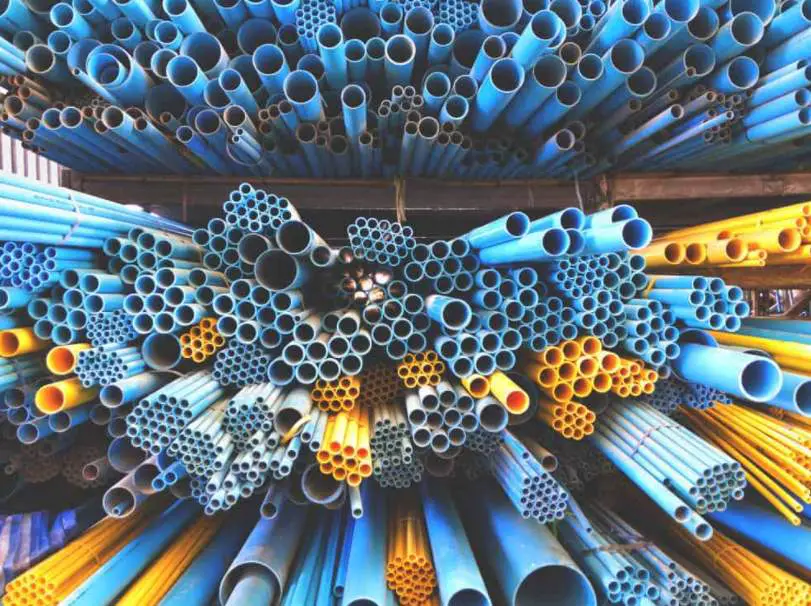
Unplasticized PVC (uPVC)
Unplasticized PVC or uPVC can be defined as not ‘made of plastic’ or by the addition of a plasticizer. The non-toxic and chemical-free variant of PVC is ideal for constructing items used with food or water.
It’s a cheaper and more durable alternative to many building materials. One of its downsides is that it can melt when exposed to high temperatures due to being a thermoplastic polymer. If this is the case, their time’s up, and they need to be taken to a recycling facility.
Chlorinated PVC (cPVC)
Chlorinated PVC or cPVC is a more robust alternative to Plasticised PVC. Its creation process involves free-radical chlorine reacting with PVC. This enables it to become vastly more heat resistant. It can be utilized at an impressive heat that can exceed 72–90 °F (40–50 °C).
The properties of cPVC deem it fire retardant. While used at such high temperatures, the ability to be less corrosive is also the main feature. It’s workable, including machining, welding, bending, and forming.
cPVC is significantly more moldable, allowing greater flexibility and crush resistance. The mechanical strength of cPVC allows it to be recommended as a replacement for many types of metal pipe in conditions where metal’s susceptibility to corrosion limits its use. cPVC is commonly used in the construction industry in piping systems, ducting, tower packings, sheets and lining.
Molecularly Oriented PVC (PVC-O)
Molecularly Oriented PVC or PVC-O is an even stronger version of chlorinated PVC. IT is fabricated by reorganizing the amorphous structure of PVC-U into a layered structure by a mechanical process. This process deems these types of products unbreakable!
Some key features of this type of PVC are their resistance to high impact, high stiffness and fatigue. They perform exceptionally well with external loading, eliminating crack propagation and offering maximum elasticity.
This type of PVC is often used when installing mains water and in the mechanical trades. E.g., venting, plant rooms, gas distributors, etc.
High impact PVC (Hi-PVC)
High impact PVC is becoming increasingly popular in the water and chemical industries. It is another form of unplasticized PVC designed to have an impact strength up to 15 times higher than that of ordinary unplasticized PVC. It is manufactured in such a way that it won’t shatter.
It offers great flexibility as well as excellent earthquake resistance. It’s light, meaning it’s easy to move, load and construct with. It is suitable for low temperatures. This type of PVC is used in construction, primarily within the piping industries. Its common uses are:
- Transportation of chilled water for air conditioning system.
- Water pipe and electrical conduit used for seismic zone or high-pressure area.
- Tap water piping in the mountain area.
- Chilled water piping.
- Dynamic flow sewage piping.
Advantages of using PVC in hydroponics
Now that we understand the different types of PVC and their case uses let’s look at why PVC is a good choice for your hydroponic setup.
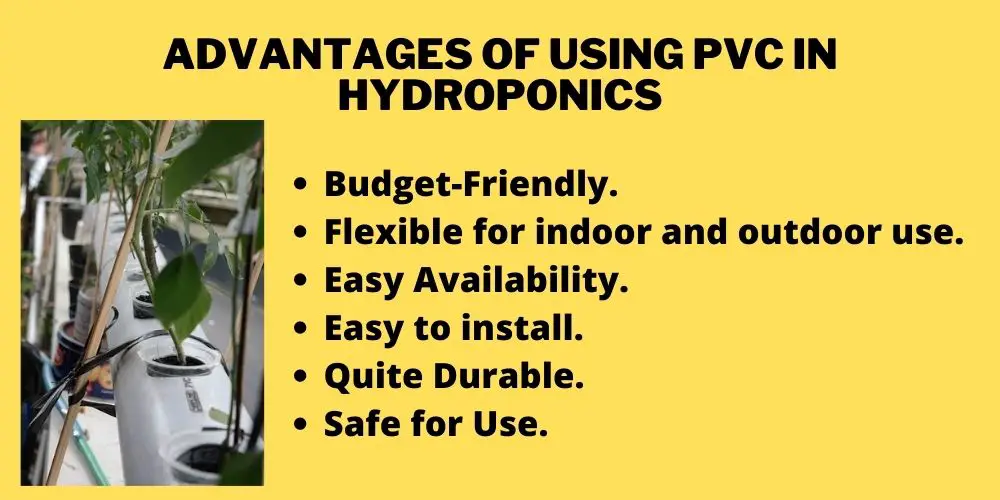
Budget-Friendly
Using PVC to create your hydroponics system is one of the best materials to build because of how cheap it is. Especially when compared with other supplies such as metal, copper, etc. Due to this simple fact, it makes being creative with your system that little bit more feasible.
You can add shut off valves or taps here and lengthen or shorten runoff pipes somewhere else without worrying about going over budget. It offers some well-received freedom that you can’t get with the more expensive materials.
Flexible for indoor and outdoor use
PVC is perfect for use both indoors and outdoors. It doesn’t matter what the weather is, and it will generally hold up and can be relied upon. Some materials have the disadvantage of possibly cracking or breaking during specific temperatures, and PVC can handle some pretty decent heat and some chilling colds.
Of course, if your system is set up outside, other aspects to focus on may affect sustainable growth. Water temperature, pests, nutrient and pH levels, and plant health must be monitored more closely.
Easy Availability
These days, PVC can be purchased almost anywhere. No jokes! You can find it at home depot stores, some larger supermarkets and dollar stores.
Even gas stations can be stocked with some bits and pieces; you’ll be surprised just how common it is. This makes building the perfect system for your needs even easier. You don’t have to plan a whole day out for supplies.
Easy to install
PVC is unbelievably easy to install. As long as you have some general knowledge of the construction industry, you won’t have too many problems. It’s as simple as using a saw to cut pipe then glue bits together.
Making sure to add the right valves and pumps is where the knowledge is needed. It’s always recommended that you have a written plan so you don’t get lost in the moment when it comes to installing. There are a lot of really good guides online, and of course, you can go and talk to a hydroponics specialist or plumber. Once you get the hang of it, it’s quite a fun type of project.
Quite Durable
We’ve touched on the durability of PVC earlier, and it goes without saying. PVC is amazingly tough, even though it’s a simple plastic construction material. The amount of testing has been through has deemed it an all-around safe bet for those who use it. Within reason, it can withstand bending, flexing, weather conditions, excess weights, etc.
Safe for Use
Having the right type of PVC will ensure that it is a safe material to use in hydroponics. As long as it has an NSF-51 or NSF-61 rating, you can be assured that it is ok to build your system.
The type of PVC deemed the safest for hydroponics is uPVC. Using the right type will make sure that no toxins or pathogens are leaked into the system, which can be detrimental to your nutrients and water supply status.
Disadvantages of using PVC in hydroponics
There aren’t too many disadvantages to using PVC to construct a hydroponics system, but here are some things to consider just to be sure.
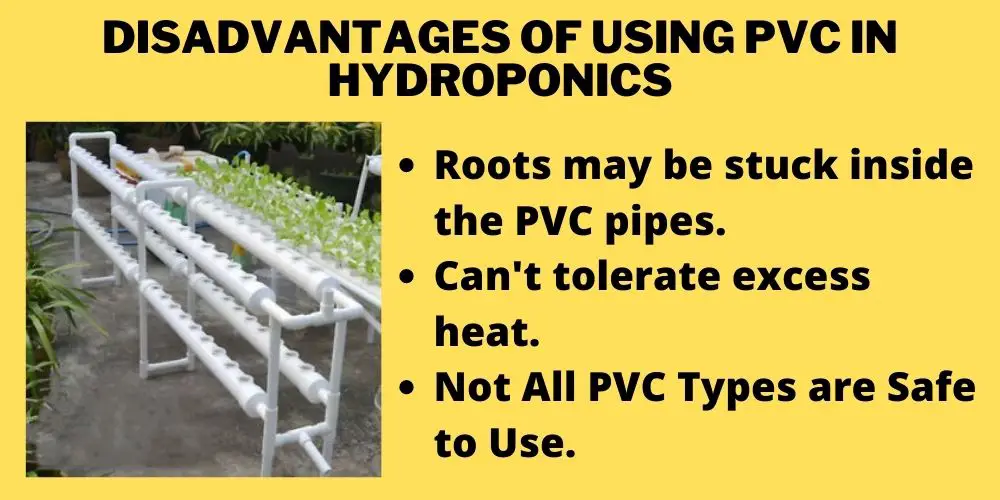
Roots may be stuck inside the PVC pipes
One of the most common issues that arise with PVC use is the clogging of the roots within the system. If the roots clog too much of the water circulation system, the other plants in the same section will lose out on precious nutrients. This could end in disaster. With a bit of patience, persistence and trial and error, though, it is not too tough a task to correct.
Giving your root a routine prune is the fastest way to make sure that you avoid any blockages. Otherwise, getting to the root cause (mind the pun) is a much more substantial long term fix. Generally, the flow or current of the water drags the roots and forces them to grow in a manner that can cause tangling. This ultimately causes blockages. You can correct the flow by either:
- Placing a flat air stone under the opening of every pipe.
- Get Wider Pipes.
- Grow Plants With Shorter Growing Periods.
- Reverse The Direction Of The Water Current.
- Place a wire mesh on the openings of your system.
Can’t tolerate excess heat
PVC can handle some pretty decent heat, but there are limits, especially if the system is set up in an area where heat is already a factor. Then adding in heat from lights, etc, and it can become an issue for the system.
You don’t generally use any hot water for hydroponics as it would kill off your plants. So the disadvantage mainly lies in the location where the system is built-in. The base temperature is 73 degrees, and it will warp at 140 degrees.
It would be difficult for a setup to get that high if you were careful in your methods. The only degradation that seems to occur via excess UV light is impact strength.
Not All PVC Types are Safe to Use
Not all PVC types should be used for a hydroponic system, as some aren’t designed to carry or transport water or food matter. NSF-51 and NSF-61 ratings are the only ones that pass the test and will stop any toxins or pathogens from leaching into your plant’s food supply.
How to Protect PVC from Heat and UV Light?
Too much heat and light can produce green algae, which can cause headaches. There are a couple of handy methods that you can use to protect your PVC from heat and UV light.
Firstly, you could wrap the pipe and accessories in an opaque material such as a film or cover. You can also paint the areas of the pipe with water-based paint formulated for exterior use. Another option is to cover the area with a tarp if the system has been set up outside. This can ensure that the UV light doesn’t reach the PVC pipe.
A well-constructed tarp system can be what ensures that your plants make it or break it! Polyester, nylon, wool and silk are also sufficient materials that can be used to create UV protection for your hydroponic system.
As a last resort, it’s wise to rethink the location that you have set up or plan to set up. Can you place it out of the way of any UV light? Can you set up some fans that help with cooling?
If you are confused about Hydroponic Indoor Lighting System: Do LED Lights Work For Hydroponics?
Best Plastic Types To Use With Hydroponics
The best plastic you can use with a hydroponics setup is High-Density Polyethylene or HDPE. It can also be commonly referred to as number 2 in the ‘plastics world’ You can find the plastic number with its symbol printed onto the plastic itself.
This type of plastic ensures that a highly reduced amount of chemicals leach into the solution within the system. Not only that, but it can be recycled, which makes it a great environmentally-friendly choice. HDPE is commonly used to manufacture food storage containers, food wrap, milk jugs, drinking water pipes, to name a few.
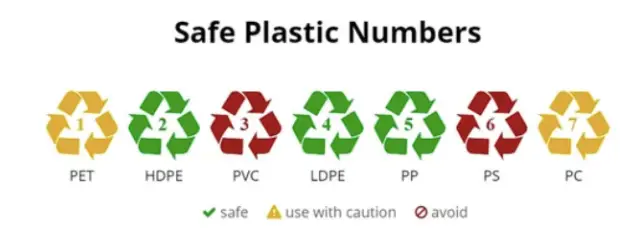
Best Non-Plastic Alternatives for Hydroponics
The best non-plastic alternatives for hydroponics include:
Copper
The upside to using copper is that it cannot emit fumes or melt or burn. However, using copper should be minimal within a system to prevent and minimize copper accumulation in the solution for your plants.
It is a great alternative for some parts, such as connectors and valves, albeit a more expensive choice. The cons outweigh the pros, though, unfortunately. The elbows/tees/straight connectors cannot simply be disconnected and reused, and the tubing isn’t flexible like PVC.
Ceramic
Another possible option to choose from is ceramic. They are great as pot/vase choices. The porcelain seed trays are also worth investigating. They are aesthetically pleasing, and using this stuff is great in theory. Its sturdy, hardwearing and like copper, keeps fumes to a minimum.
The issue is connecting them effectively to the rest of the system. Furthermore, it’s common to experience a crystal salty build-up over time, which can harm the EC and pH levels.
Frequently Asked Questions (FAQs)
01. What is food grade plastic?
Food grade plastic is a type of plastic that meets a specific purity standard that enables it to be used with or for food. It is not manufactured using any dyes or recycled materials that can cause potential harm to living beings.
The purity process and resulting approval have a very important purpose. If the plastic isn’t deemed pure, there is a possibility that foods or beverages with alcohol and/or acidic characteristics can react with non-pure plastic. This, in turn, can cause toxins to leach into food or beverages.
The top 5 FDA-approved food-grade plastics are:
➤ High-Density Polyethylene (HDPE).
➤ Polypropylene (PP).
➤ Acrylic (PMMA).
➤ Acrylonitrile Butadiene Styrene (ABS).
➤ Polyetheretherketone (PEEK).
If you had to choose just one, the best type would be high-density polyethylene (HDPE). This is indicated by the “2” symbol on the colored “Safe Plastic Numbers’ image above.
Keep in mind that only virgin or non-recycled HDPE is food safe. In saying that, products with the HDPE stamp have been reviewed by the FDA and approved for use with or for food.
02. Is PVC safe for aquaponics?
PVC is perfectly safe to use to construct an aquaponics system. As long as uPVC is used and has an NSF-51 and/or NSF-61 rating, you can be assured that you won’t have any issues.
This type of PVC is safe for the fish, the water and, of course, the plants. It’s even a great option to help separate species like fish and shrimp. If vertical aquaponics is something you want to pursue, it is a very good choice.
Conclusion
PVC comes in a range of different types, sizes and shapes with various characteristics. These are all designed to suit specific needs. In the case of a hydroponic system, PVC is a top-rated option. It’s cheap, lightweight, flexible within its construction, easy to install, and supreme availability.
I hope now you have a clear idea when it comes to the question “Is PVC safe for hydroponics?”, so next if any plant head asks you this question, share your knowledge. If you still have any confusion let me know in the comment box


